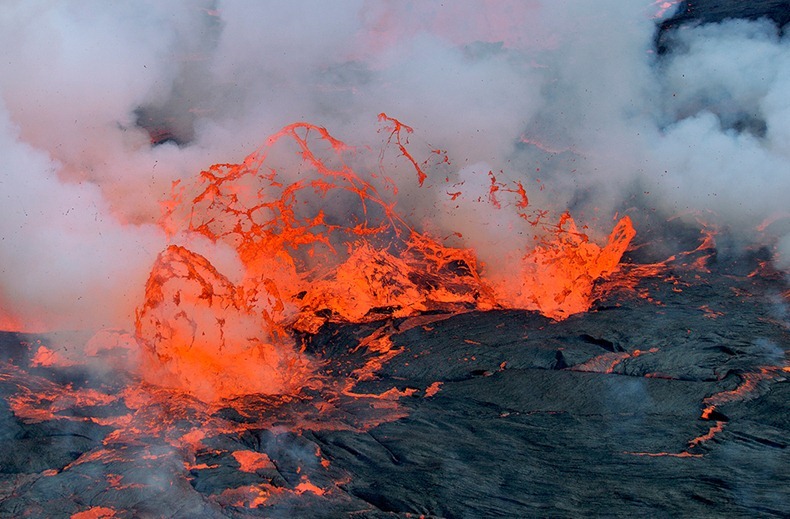Lava Lake at Nyiragongo Volcano
Mount Nyiragongo is located inside Virunga National Park, in
the Democratic Republic of the Congo, about 20 km north of the town of
Goma and Lake Kivu. It is one of the most active volcanoes in Africa,
and one of eight volcanoes in the Virunga Mountains. The main crater is
about two km wide and usually contains a lava lake which appear in the
summit crater.
Nyiragongo's lava lake has at times been the
most voluminous known lava lake in recent history. The depth of the lava
lake varies considerably depending on the activity of the volcano. A
maximum elevation of the lava lake was recorded at about 3250 m (10,700
ft) prior to the January 1977 eruption - a lake depth of about 600 m
(2000 ft). A recent very low elevation of the lava lake was recorded at
about 2700 m (8800 ft).
Not much is known about how long the
volcano has been erupting, but since 1882, it has erupted at least 34
times, including many periods where activity was continuous for years at
a time, often in the form of a churning lava lake in the crater.

The lava emitted in eruptions at Nyiragongo is often unusually fluid, possibly due to the presence of melilite nephelinite, an alkali-rich type of volcanic rock having unusual chemical composition. Because of the extreme fluidity, Nyiragongo's lava flows can race downhill at up to 60 miles per hour (up to 100 km/h), whereas most lava flows at a walking pace and rarely pose a danger to human life.
Between
1894 and 1977 the crater contained an active lava lake. On 10 January
1977, the crater walls fractured, and the lava lake drained in less than
an hour overwhelming villages and killing at least 70 people. Some
reports quote much higher figures of up to several thousand people. The
hazards posed by eruptions like this are unique to Nyiragongo. Nowhere
else in the world does such a steep-sided stratovolcano contain a lake
of such fluid lava.
Another major eruption of the volcano began
on January 17, 2002. Lava from the reformed lava lake streamed out in
200 to 1000 m wide streams and up to 2 m deep. Warnings had been given
and 400,000 people were evacuated from the city across the Rwandan
border into neighbouring Gisenyi during the eruption. Despite the
precautionary measures, about 147 people died in the eruption from
asphyxiation by carbon dioxide and buildings collapsing due to the lava
and earthquakes.
Six months after the start of the 2002
eruption, Nyiragongo volcano erupted again. Activity at Nyiragongo is
ongoing, but currently confined to the crater, where another lava lake
has formed about 250 metres below the level of the 1994 lava lake.
In
June 2010, a team of scientists and intrepid explorers stepped onto the
shore of the lava lake boiling in the depths of Nyiragongo Crater.
These pictures are from the trip, by photographer Olivier Grunewald.















